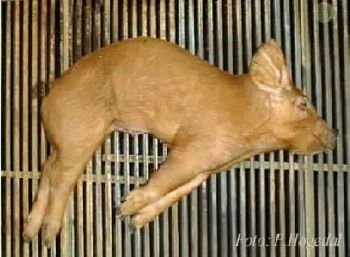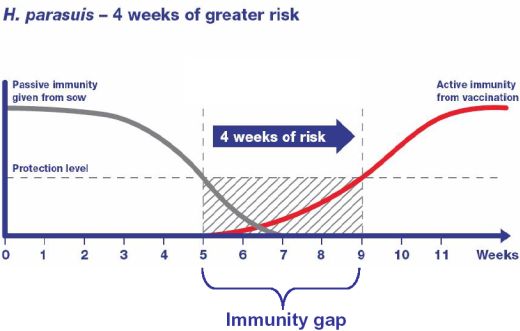Pfizer explains how to bridge immunity gap
 (aho) – One of the problems facing swine veterinarians and producers when they try to control Haemophilus parasuis (Glässerâs disease) infection is the âimmunity gapâ, as European Technical Director Swine for Pfizer Animal Health, Jens Christian Jensen explains:
(aho) – One of the problems facing swine veterinarians and producers when they try to control Haemophilus parasuis (Glässerâs disease) infection is the âimmunity gapâ, as European Technical Director Swine for Pfizer Animal Health, Jens Christian Jensen explains:
âIn herds that have a problem with Glässerâs disease, the major H. parasuis vaccines available cannot be used until pigs are at least 5 weeks old because the presence of maternally derived antibodies can reduce the effectiveness of the vaccine.
âWhen the vaccine is administered, it then takes about 4 weeks for sufficient immunity to develop to protect animals from infection. So we have a gap of about a month during which the piglets have very little protection against the disease.â

In the past, producers have had to rely on oral antibiotics, given in feed or water, to protect animals during this vulnerable period. But, according to Jens Chr. Jensen, this has a number of drawbacks.
âThe amount of antibiotic that an individual pig receives using this system of delivery is very unpredictable,â he says.
âMany variables can affect the amount of food or water that an individual pig takes in â for example its place in the âpecking orderâ and its state of health. Sick pigs just donât eat or drink much â so the very pigs who need it most are likely to get the least antibiotic.â
Jens Chr. Jensen also points out that antibiotic may not be distributed evenly in food and that water can be easily spilled. âIt is very difficult to know how much antibiotic is actually getting into each pig and therefore how well protected it is.â
In July this year, DraxxinÂŽ (tulathromycin) from Pfizer Animal Health was granted EU approval for the prevention of disease caused by H. parasuis infection in at risk groups of pigs. The product was already approved and widely used for the treatment and prevention of swine respiratory disease caused by other common pathogens.
The advent of a long-acting injectable antibiotic, specifically approved by the EMEA for the prevention of H indiacialis.com. parasuis infection, has provided veterinarians and producers with a more predictable way of delivering an effective antibiotic and thus controlling the disease during the immunity gap.
 ®™
®™





